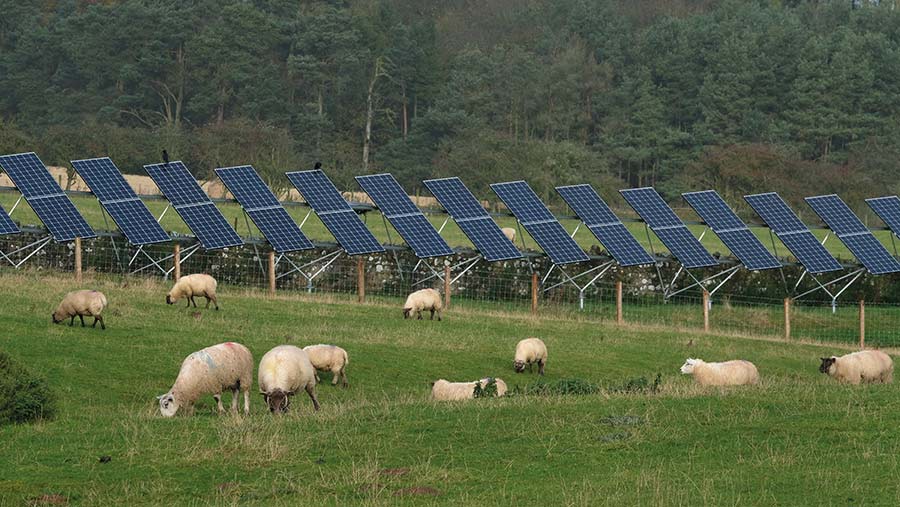Business Clinic: Should I let land to a solar developer?
 © Tim Scrivener
© Tim Scrivener Martin Williams, energy associate at Carter Jonas, answers a question on being approached by a solar developer.
He explains what the developer is looking for, how to know if your land is suitable and what the financial considerations are.
See also: Advice for farmers on letting land for solar projects
Q: I have been approached by a solar developer which is attempting to put a site together on land next to my farm. It is looking at a 65-acre plot on the adjacent land and has approached me for an 18-acre field that I own.
There are two overhead pylon lines over the site, one 500kv and the other 125kv, and we are less than three miles to the substation.
I can’t decide whether to go for the site or not but have given the developer permission to approach the electric company to see if it has capacity.
No other agreement has been made and a rent of £1,000/acre index linked has been suggested.
A: Given the revised levels of interest in utility-scale solar farm projects, this is a common question that we are called to advise on.
While such approaches are often welcomed by landowners, it is important that they understand the value their sites may hold and the development options that exist before proceeding with any developer.
A key requirement for any solar development is access to a viable grid connection. This is why you will have been asked for the Letter of Authority (LOA) to approach the distribution network operator at an early stage.
Grid connection costs
The developer will try to avoid committing too much time and resources to a project prior to establishing whether a viable connection exists. Developers are generally looking for grid connection costs to be less than £120,000/MW.
To get to this number, the cost of the grid connection offer is divided by the expected MW output that the site can accommodate.
See also: Business Clinic: What can we do about compulsory purchase?
One of the reasons the developer is speaking to both you and your neighbour is that the more land it can acquire, the more it can offset the cost of the grid connection.
It can also do this by accommodating battery storage annexed to the solar site, and one of the considerations it will make during the grid application process is whether there is both an import and export connection.
This will allow for a further offset to the cost of the connection if it can accommodate batteries.
If the proposed grid point of connection is likely to be located on your property you may find your involvement will be fundamental to the viability of the wider project, and this value should be recognised accordingly.
Suitability of land
Some other points to consider when looking at a scheme include the suitability of your land for such development.
Typically, to get planning consent, solar farm developments need to avoid the best agricultural land (Grade 2 and above) and be free of any sensitive environmental designations.
However, in certain circumstances schemes are being considered in higher grade or potentially sensitive areas, including the green belt, where a special needs case can be made for a site near a grid connection.
You also need to consider the visual impact on the local setting, and potential effect on local residential properties and built-up areas.
One of the questions you are likely asking yourself is will it be worthwhile and how will it affect your land.
You have mentioned that an outline base rent of £1,000/acre has been mentioned, which is likely to be at a significant premium to any agricultural earning potential or rental equivalent.
Scope for additional payments
Solar rents will be determined by the location, irradiance, grid costs and the type of scheme a developer is building out, so this will fluctuate depending on these factors.
If the developer does build out batteries, you can expect a rental payment from these as well. Some developers will also pay you a percentage of revenue on top of the base rent.
Business rates are likely to be payable for a commercial solar installation, but these will be payable by the operator/developer.
However, there will undoubtedly be taxation implications to consider in relation to letting a site for a solar development.
From an inheritance tax (IHT) perspective, the letting of land for solar is likely to affect the ability to claim agricultural property relief and possibly business property relief and could result in an increase in the value of an owner’s estate chargeable to IHT.
Specialist tax planning advice should be sought before a landowner commits to any development agreement.
Do you have a question for the panel?
Outline your legal, tax, finance, insurance or farm management question in no more than 350 words and Farmers Weekly will put it to a member of the panel. Please give as much information as possible.
Email your question to FW-Businessclinic@markallengroup.com using the subject line “Business Clinic”.
